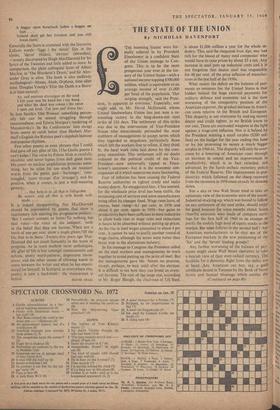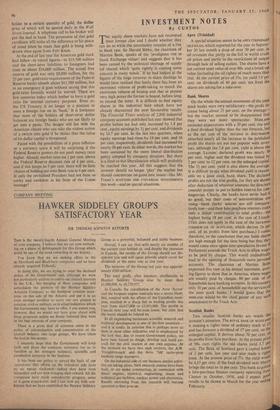THE STATE OF THE UNION
By NICHOLAS DAVENPORT
`THE booming Sixties' were for- mally ushered in by President Eisenhower in a confident State of the Union message to Con- gress. This is to be the most prosperous year ever in the his- tory of the United States—with a national income topping 5500,000 million, which is equivalent to an average income of over £1,000 per head of the population. 'Our surging strength,' said the Presi- dent, 'is apparent to everyone.' Especially, one might add, to Mr. David McDonald, whose United Steelworkers Union has just won a re- sounding victory in the long-drawn-out steel strike of 116 days. The settlement of this strike was due to the intervention of Vice-President Nixon who miraculously persuaded the most stubborn of managements to accept terms which they regarded as iniquitous, particularly those which left the workers free to refuse, if they think fit, the local work rules laid down by the com- pany executives. This settlement will no doubt redound to the political credit of the Vice- President—now universally tipped as Eisen- hower's successor—but it is the economic con- sequences of it which seem to me more fascinating.
Fear of inflation has been causing the Federal Reserve authorities to tighten credit and make money dearer. An exaggerated fear, it has seemed. for the wholesale price level has been stable, the increasing cost of services and some manufactures being offset by cheaper food. Wage rates have, of course,• been rising-41 per cent. in 1958 and about 4 per cent. again in 1959—hut gains in productivity have been sufficient in most industries' to allow both rises in wage rates and reductions in hours to be absorbed without putting up prices. As the rise in steel wages amounted to about 4 per cent., it cannot be said to justify another round of wage claims, although the terms were better than those won in the aluminium industry.
In his message to Congress the President called on the steel workers and managements to work together to avoid putting up the price of steel. But the managements gave Mr. Nixon no promise, except, perhaps, to wait until after the election. It is difficult to see how they can avoid an event- ual increase. The cost of the wage rise. according to Mr. Roger Blough, the chairman. of US Steel.
is about $1,000 million a year for the whole in- dustry. This, said the magazine Iron Age, was 'too rich for the blood of many steel companies' who would have to raise prices by about $5 a ton. Any increase in steel puts up industrial costs and it is not forgotten that dearer steel was responsible for 40 per cent. of the price inflation of manufac- tures in the last half of the 1950s.
What makes the deficit on the balance of pay-
ments so ominous for the United States is that hidden behind the huge external payments for military defence and economic aid is the slow worsening of the 'competitive position of the American exporter, the gradual increase in Ameri- can costs relative to the British and European. This disparity is not overcome by making money dearer and credit tighter, as we British know to our cost.,These are outmoded weapons in the fight against a wage-cost inflation. Nor is it helped by the President winning a small surplus ($200 mil- lion) on the budget for the year ending this June or by his promising to secure a much, bigger surplus in 1960-61. The disparity will only be over- come by a lowering of American costs through an increase in output and an improvement in productivity, which is in fact retarded, not advanced, by the harsh archaic monetary policy of the Federal Reserve. The improvement in pro- ductivity which followed on the sharp recovery from the recession in 1958 must already he slowing down.
For a day or two Wall Street tried to take an optimistic view of the economic state of the union. Industrial stocking-up, which was bound to follow on any settlement of the steel strike, should make for good business for some months ahead. Some cheerful estimates were made of company earn- ings for the first half of 1960 in an attempt to justify the unduly high level of equity stocks in the market. But what follows in the second half? Are American. manufacturers to be shut out of the European markets in the new positioning of the Six' and the 'Seven' trading groups?
Any further worsening of the balance of pay-
ments might cause Wall Street operators to take a bearish view of their over-valued currency. The facilities for a domestic flight from the dollar are at hand. ,Any American can buy, say, a gold certificate issued in Toronto by the Bank of Nova Scotia and Samuel Montagu which entitles the
(Continued on page 86)
holder to a certain quantity of gold, the dollar price of which will be quoted daily in the Wall Street Journal. A telephone call to his broker will put the deal in hand. The possession of that gold certificate will make all the difference to his peace of mind when he reads that gold is being with- drawn once again from Fort Knox.
At the end of last year the American gold stock had fallen—in round figures—to $19,500 million and the short-term liabilities to foreigners had risen to about $16,000 million, The actual free reserve of gold was only $8,000 million, for the 25 per cent. gold ratio requirements of the Federal Reserve banks absorb about $11,500 million, but in an emergency it goes without saying that this gold-ratio formula would be waived. There are few countries today which bother to have a gold ratio for internal currency purposes. Even so, the US Treasury is no longer in a position to meet a foreign run on its 'bank.' It is fortunate that most of the holders of short-term dollar balances are foreign banks who are not likely to get into a panic. The danger still lies with the American citizen who can take the violent action of a switch into gold if he thinks that the value of his dollar capital is threatened.
Faced with the possibilities of a price inflation or a currency scare it will be surprising if the Federal Reserve powers do not push money rates higher. Already market rates are z per cent. above the Federal Reserve discount rate of 4 per cent., and if this jumps to 5 per cent. there will be little chance of holding our own Bank rate at 4 per cent. If only the revitalised President had not been so cocky and confident in his State of the Union message !



































 Previous page
Previous page